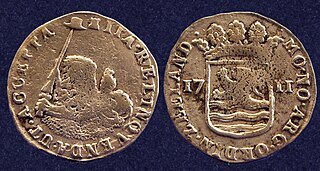
The Houtman Abrolhos is a chain of 122 islands, and associated coral reefs, in the Indian Ocean off the west coast of Australia, about eighty kilometres (50 mi) west of Geraldton, Western Australia. It is the southernmost true coral reef in the Indian Ocean, and one of the highest latitude reef systems in the world. It is one of the world's most important seabird breeding sites, and is the centre of Western Australia's largest single-species fishery, the western rock lobster fishery. It has a small seasonal population of fishermen, and a limited number of tourists are permitted for day trips, but most of the land area is off limits as conservation habitat. It is well known as the site of numerous shipwrecks, the most famous being the Dutch ships Batavia, which was wrecked in 1629, and Zeewijk, wrecked in 1727.

Zuytdorp, also Zuiddorp was an 18th-century trading ship of the Dutch East India Company.

Western Australia (WA) is divided into regions according to a number of systems.

Acacia rostellifera, commonly known as summer-scented wattle or skunk tree, is a coastal tree or small tree in the family Fabaceae. Endemic to Western Australia, it occurs along the west coast as far north as Kalbarri in the Southwest Australia savanna ecoregion, and along the south coast as far east as Israelite Bay.

Geographe Bay is in the south-west of Western Australia around 220 km southwest of Perth.

Moore is an electoral district of the Legislative Assembly in the Australian state of Western Australia.
Over 1400 ships have been wrecked on the coast of Western Australia. This relatively large number of shipwrecks is due to a number of factors, including:

Jurien Bay is a coastal town in the Wheatbelt region of Western Australia, 220 kilometres (137 mi) north of Perth facing the Indian Ocean.

Yalgoo is an interim Australian bioregion located in Western Australia. It has an area of 5,087,577 hectares. The bioregion, together with the Avon Wheatbelt and Geraldton Sandplains bioregions, is part of the larger Southwest Australia savanna ecoregion as classified by the World Wildlife Fund.

Exmouth Gulf is a gulf in the north-west of Western Australia. It lies between North West Cape and the main coastline of Western Australia. It is considered to be part of the Pilbara Coast and Northwest Shelf, and the Carnarvon Basin geologic formation. It was named after Edward Pellew, 1st Viscount Exmouth by Phillip Parker King in 1818.
Western Australia has the longest coastline of any state or territory in Australia, at 10,194 km or 12,889 km. It is a significant portion of the coastline of Australia, which is 35,877 km.
The south coast of Western Australia comprises the Western Australian coastline from Cape Leeuwin to Eucla. This is a distance of approximately 1,600 kilometres (1,000 mi), fronting the Great Australian Bight and the Southern Ocean.

Mount Lesueur is a near-circular, flat-topped mesa located 21 kilometres (13 mi) from Jurien Bay in Western Australia. It rises above the surrounding lateritic plain of Lesueur National Park which has eroded away around it.

The Jurien Bay Marine Park is a protected marine park that is located 200 to 300 kilometres north of Perth, off the coastal tip of the Wheatbelt region of Western Australia. The 82,375-hectare (203,550-acre) marine park was formally declared on 31 August 2003 and is situated along the Indian Ocean Drive that extends south from Green Head to the southern boundary of Nambung National Park. It includes many of the islands located in this region.
Coral Coast is a tourism promotion name for the coastal region along Western Australia's mid western coastline between Cervantes and Exmouth.
Kimberley coastline is a coastal region at the ocean edges of the Kimberley land region in the northern part of Western Australia.
Main Roads Western Australia controls the major roads in the state's Mid West region. There are four main highways through the Mid West: The north-south coastal route of Brand Highway and North West Coastal Highway, the inland alternative Great Northern Highway, and the northern section of Goldfields Highway, which links Meekatharra with Kalgoorlie. A network of main roads connects towns within the Mid West to each other, the highways, and neighbouring regions, with local roads providing additional links and access to smaller townsites. Roads are often named after the towns they connect.
Turquoise Coast is a name attributed to a section of the coastline of Western Australia in the vicinity of Jurien Bay.

The Pilbara Coast is the coastline of Western Australia's Pilbara region. It is often referred to as the North West Coast of Western Australia.

Inneston is a locality in the Australian state of South Australia located on the south-western end of Yorke Peninsula about 155 kilometres west of the state capital of Adelaide. Historically, it is notable as a site for the mining of gypsum and since 1970, the majority of the land within the current extent of the locality is within the protected area called the Innes National Park.
This page is based on this
Wikipedia article Text is available under the
CC BY-SA 4.0 license; additional terms may apply.
Images, videos and audio are available under their respective licenses.












